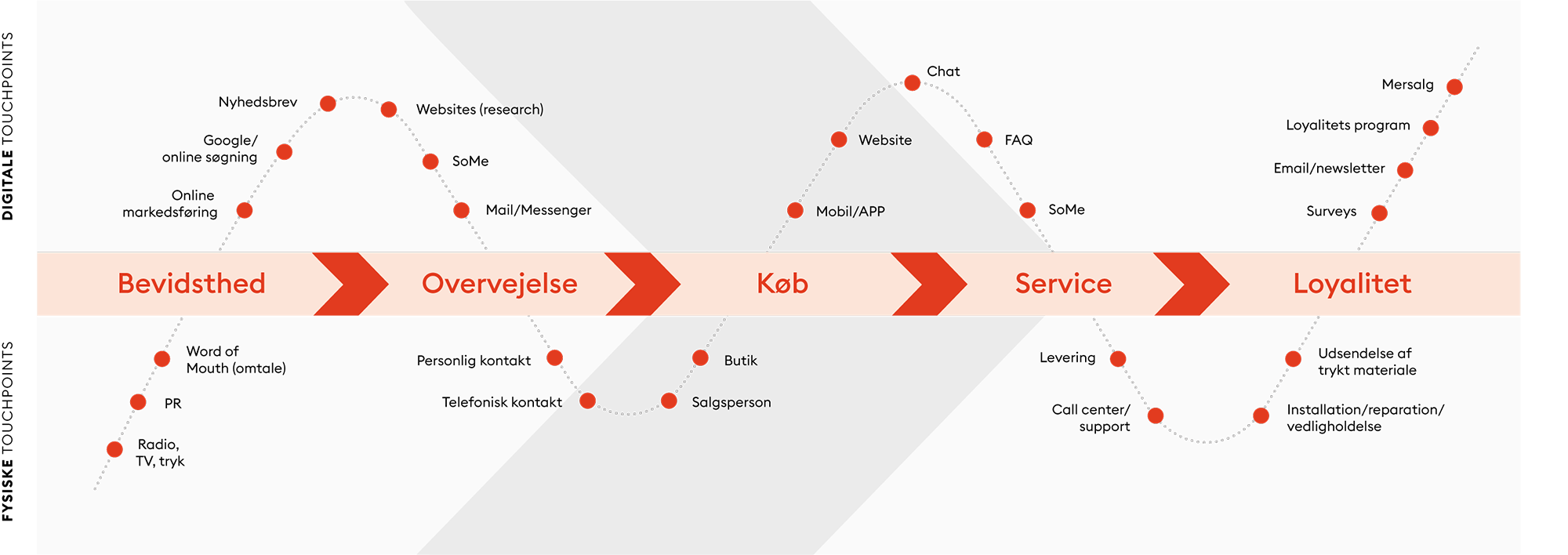Get a handle on the customer journey.
What is the customer journey?
A customer journey is the total experience a customer goes through, from the first encounter with your company, service, or product to the post-purchase phase. It is important to understand that a customer journey is not just about the purchase itself, but about all the touchpoints and interactions along the way – both physical and digital. Your potential customers might encounter you already in their research and inspiration phase if your company shows up as a search result when they are looking for the best product or solution to a current need.
Do you know how visitors act when they see your website for the first time? Do you understand your target audience’s situation and needs so you can create relevant content and help them on their customer journey? In today’s competitive business world, delivering a great customer experience is crucial. An effective way to improve the experience is by mapping and understanding the customer journey.
Map the customer journey.
A customer journey can be divided into several phases, which can be both digital and physical:
- Awareness phase: In this phase, the customer realises that they have a problem or need that they want resolved. This is when the customer seeks information and inspiration. It is during this phase that the customer becomes aware of your brand or product if your company is visible through marketing channels, recommendations, Google searches, etc.
- Consideration phase: The customer researches and evaluates different options – including how your business can fulfil their needs.
- Purchase phase: The customer completes the purchase and interacts with your company during this phase.
- Service phase: The customer is serviced after the purchase, including support and delivery.
- Loyalty phase: In the loyalty phase, you can offer repair and maintenance of the product/service the customer has purchased. It is also during this phase that you can introduce loyalty programmes to generate additional sales.
There can be many steps in the customer journey, and it rarely goes from A to B in a single straight path, as buyers often move back and forth and use different channels when seeking out a product or service. Do you know the possible touchpoints for your company and how your customers experience them?

Optimise the customer experience.
Mapping the customer journey may seem overwhelming, but it is nevertheless a good idea. One of the key reasons is that it provides insight into your target audience’s needs and helps you understand why your potential customers act and make decisions the way they do. And where they might jump ship. By knowing the customer journey, you gain valuable insights that can be used to optimise the customer experience.
Customer journey mapping is a closer look at every step along the way and thus all the places where your customers or target audience interact with you. It helps you identify potential points of distress, gaps, and areas that need improvement. Do customers encounter problems or frustrations along their journey? For example, long waiting times, lack of information, or cumbersome processes.
You can determine if new touchpoints need to be established or if some are redundant and not valuable to your customers. Perhaps some touchpoints can be optimised to be more intuitive, informative, and user-friendly. For example, it is important that the navigation on your website is clear and understandable so that customers can find the right products, make purchases, and get support.
All the knowledge you gain from customer journey mapping can be used to raise your company’s visibility, increase customer satisfaction, and create even more relevant content by customising it to your target audience and their needs to increase the likelihood of a purchase or collaboration. In other words, you can use the insights gathered to improve all your customer touchpoints and optimise the customer experience.
A successful customer journey is essential for satisfied and loyal customers, but the journey changes over time, so it is important to continuously evaluate and improve your company’s customer experience. Listen to customer feedback, monitor trends, and adapt your processes and interactions to meet changing needs and expectations.
If you understand the customer journey and constantly optimise it, you are well on your way to help, inform, and inspire your customers.
design concern understands your needs and those of your customers.
At design concern, we have helped many companies map customer journeys and optimise touchpoints to make them attractive to customers – and easy for you to manage. Want us to help you map the customer journey too? Then please do not hesitate to get in touch with us.